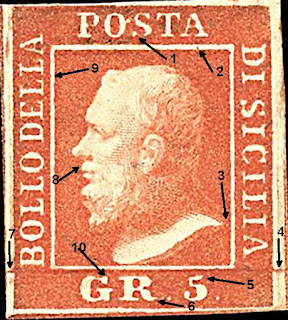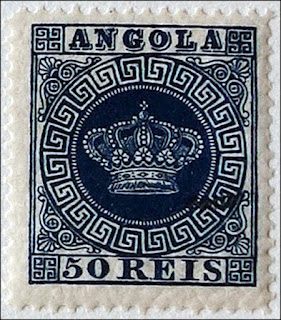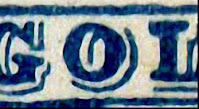Angola was a Portuguese colony in S.W. Africa
It was settled in the 15th and 16th century.
It became independent in 1975.
Angola got his name from Ngola (which means king, after the kingdom of Ndongo).
Original Issues
Genuine Features
1. The corner gammadions (spandrels) are very evenly shaped and are mirror images of each other with top & bottom facing in different directions
2. The scallop shape on the right has a bigger central lobe than the others. They are very close to the frames but do not touch
3. Maltese cross attached to the orb, on some forgeries it is not attached and just a plain cross. The cross also has a slight tilt to the right
4. The inner frame line is generally thinner than the outer one. Over inking may not show this & I have seen some where the outer right line appears thinner
5. & 9. The frame line extends to the outer one in all corners
6. The numerals and letters are all evenly sized with prominent serifs that are mostly curved
7. The genuine has 121 dots in the ring
8. Crown lobes have 9, 10, 5, 10, 9 pearls, perfectly round, easy to count.
The Angola issue is different from the other Colonies in the shape of the lobes of the
crown. This is round for Angola but oval and angular on all the other Colonies. The corner gammadions are also different as shown below.
A Note of caution
Forgeries
Forgeries are VERY numerous and most were mainly sold by Fournier and Spiro.
They greatly outnumber the originals.
Collectors should especially beware of the 20r bister, 25r rose (perf 14) , 40r blue and 50r green whose high CV makes them prime targets for forgery.
Fournier Forgery
The Fournier collection has a large quantity of full sheets and singles of all the Colonies but there is no evidence that he did anything other than resell them from another source
Features
- The printing is less sharp and lines rougher, particularly noticeable in the lettering but a good forgery.
- Shade line inside the "O" in "ANGOLA" is incomplete
- The cross on top of the crown is less detailed with small sections and usually detached from the orb
- The letters appear to be thicker
- The pearls around the crown are smaller
- The right clamshell has an incomplete line and the result is a heart shape
2 Common postmarks on Angola Fournier stamps
Slanted A Forgery
Features
- The source is unknown and overall crudely executed
- The top letters are very uneven in particular the slanted last A
- The shadow line in the O is incomplete
- The cross is wrong and separated from the orb
- The pearls in the crown are uneven
- The pearls in the ring are uneven and missing
 |
| Slanted A & Original |
Swastika Forgery
Features
- The corner spandrels are in the shape of swastikas and all face in the same direction
- The cross is tilted to the right and the wrong shape
- Some scallop shapes have too many lobes
- The base of the crown is inclined
- The crown pearls are not round and the number of them is wrong
- The letters are poorly executed
- The top letters are very tall
- The pearls are uneven, there are only four pearls on the central arm of the crown
Spiro Forgeries Types I & II
NOTE - These are noted as being from Spiro but the cancels are also seen on Torres/Usigli forgeries. Spiro has noted he did not make any forgeries but obtained them from other sources
Features
In all denominations
- The "R" in "REIS" starts from the center of the stamp while in the genuine it starts left of the center
- The "A" leans to the right
- The crown is rounder
- The 5 has a flat top
- The cross is separated from the orb
- The "G" has a curved protrusion on the bottom right
- The central line of pearls is almost invisible
The Type 2 on the right has even less details
Large Cross Forgery
Features
One of the better forgeries
- The cross on top of the crown is larger, clearly detached and not symmetrical
- The three lower pearls of the central arm are flattened.
- The lines under "ANGOLA" and over "5 REIS" do not touch the end frame.
- The "REIS" letters are thick and too close together
- The shading line in the "O" is in a different position
- The "GO" is larger than the other letters
- The "5" is oddly shaped
- Crown pearls are 8-10-5-10-8 instead of 9-10-5-10-9
- The frame lines above the value & below the top do not extend to the outer frame.
Tapered Base Forgery
Features
- The crown has a tapered base
- The "G" has a thin top
- The "5" is not curved on top as much as the original
- The cross is plain with a larger central hole
- The "R" han an upturned serif on the right leg
- The spandrels do not match
Unknown Item
This may be a forgery or just a variant
- The "A" is placed very high
- Borders are uneven and the same thickness
- The "NG" may be touching the frame
Small "50" Forgery
Features
- The small "50 REIS" is the obvious issue
- The cross is not Maltese and ha s large central hole
- The "G" is oddly shaped
- The crown has too many pearls and the central jewels are wrong
- The crown is too rounded
- The scallops are all the same
A similar forgery appears in other Colonies and is reported to be a Torres forgery
Other Colonies
It may be helpful to show other Colony forgeries as similar ones may show up in Angola.
These are perfed but initially the background color was not helpful so they were cropped
The "Brazilian" Forgery
FeaturesIt appears this forgery has roots in Brazil
The E in CORREIO has a large mark on its top right.
In the right top gammadion, one of the squares has a coma shape
The forgeries seen are obliterated with a wide bar cancel.
The "Circle" Forgery
Featureshe orb under the cross has been replaced with a circle
The pearls in the crown are small
The letters in MACAU are thin
The corner spandrels are not scalloped but angular (sides are straight)
Crude Forgery
- Distorted letters
- Spandrels all the same
- 4 pearls in center crown line
- Uneven large value
Possibly a Torres forgery
This is the only known Sperati forgery
There is a white spot in the tail of the R of REIS
There is a minute break at the top of the numeral 2




















































